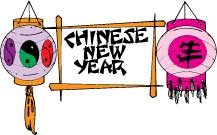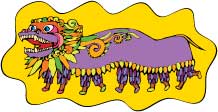
This year the Chinese New Year falls on February 10. In China, the Year of the (Blackwater) Snake will be celebrated on Sunday and Monday. Sunday is a new moon day, and is often referred to as the "Lunar New Year." We've compiled some fun ways to celebrate this festival in your math class.
The foam diamond-back snake hanging on the door in the photo below was created by our first-grade friend Tyler. We added a string to some of Tyler's snake creations and had snake races around our patio. You can let your students have snake races and/or hang the snakes around your room in various poses. Give your students craft foam or construction paper, markers, tape and scissors. After cutting out snakes of various lengths, your students can compare them to find the shortest and longest. (Make sure names are on the snakes so they get back to their proper owners.) The students can use inch and centimeter rulers to measure the lengths and then create a table or bar graph showing the lengths of all the snakes in your class.
Download paper rulers here. When you copy them, the size may change slightly, but as long as your students all use copies from the same original, it won't matter for comparing length. You might invite a local reptile keeper to bring a non-poisonous snake for your students to examine or hold. Have the students research and write brief reports on some of the snakes in your area so they can talk about snakes with your local expert. Before the presenter arrives, brainstorm questions the students could ask and use the questions for a Q & A time after the snake is introduced.
A few year ago here at
Excel Math, we were greeted one morning by a rattlesnake who happened to slither his way into our offices in the predawn hours of the day.
Fortunately, Jim found some rather long trash tongs and was able to use them to remove the snake safely from the building. This photo was taken shortly after the snake was discovered. It blended into the carpet rather nicely.
Since the snake is not a welcome reptile in China, some people who are born in the year of the snake prefer to say they are born in the "year of the small dragon."

The snake has a forked tongue considered to be a sign of being argumentative. In the Chinese
zodiac, the snake implies potential trouble from libel, dispute or
slander. Read more about the Chinese New Year and other festival days at
ChineseNewYearDay.com.
In
Excel Math, we help build confident, successful math students. Here's a question about China's population from our Grade 5 Excel Math Guided Practice 95:
In 1950, the population of China was 562,580,000 and
in 1990 it was 1,138,895,000. Which choice is the closest to the
increase in China's population between 1950 and 1990?
a. 5 billion
b. 60 billion
c. 500 million
Chinese New Year's Eve is a day of family reunions. Your students could each create a family scrapbook (print or online or both) complete with photos, stories, and a family tree. If they know the ages of some of the older people in their families, let them calculate their year of birth (or vice versa—if they know the birth year, have them calculate the age). Talk about some of the things that were not yet invented when their grandparents and great-grandparents were born.

Let your students bring Chinese food, clothing, toys, money and other objects to display. Show pictures of China—the land and its people while listening to Chinese music and trying some Chinese food. If you know someone who has lived in China, have them visit your class and share some of their experiences with your students.
The Chinese people celebrate the Chinese New Year for 15 days, ending with the Chinese Lantern Festival. Make paper lanterns to hang around your classroom. You'll find directions for making colorful paper lanterns at
Enchanted Learning. Continue your own classroom celebration through the end of February, if you like.
How do you help your students learn about other cultures and holidays? Leave a comment in the box below with your suggestions.
New to
Excel Math? Take a look at our proven mathematics curriculum for elementary students at
ExcelMath.com and request your free samples. Then take a quick tour of Excel Math at
http://www.excelmath.com/tour/tour01.html.
































